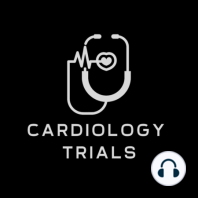10 min listen
Review of the TRACE Study
ratings:
Length:
10 minutes
Released:
Feb 13, 2024
Format:
Podcast episode
Description
NEJM 1995;333:1670-6.Background Up to this point in history, a series of trials had been conducted using ACEi’s in post-MI patients. A small to moderate short-term benefit had been shown when the drugs were started immediately (GISSI-3 and ISIS-4) and much greater long-term benefits were demonstrated when the drugs were started 5-11 days, on average, following AMI in patients with LV dysfunction and congestive heart failure (SAVE and AIRE).The SAVE and AIRE trials, however, were more selective and it was not clear how representative they were among all potentially eligible patients. Thus, TRACE authors sought to re-test the hypotheses tested in SAVE and AIRE with a focus on generalizability of trial procedures and results. Specifically, the Trandolapril Cardiac Evaluation Study (TRACE) sought to test the hypothesis that trandolapril would reduce all-cause mortality in post-MI patients with LV dysfunction when used in the majority of consecutively screened, potentially eligible patients.Cardiology Trial’s Substack is a reader-supported publication. To receive new posts and support our work, consider becoming a free or paid subscriber.Patients Consecutive patients ≥18 years of age who were hospitalized with a confirmed AMI were screened between day 2 and 6 after the onset of symptoms. All screen eligible patients underwent echocardiography and those with a wall motion index of ≤1.2, which corresponds to an EF ≤35%, were considered for enrollment. The key exclusion criteria included an absolute or relative contraindication to an ACEi or a definite need for an ACEi, severe uncontrolled diabetes, a serum sodium <125 mmol per liter or a serum creatinine >2.3 mg/dl.Baseline characteristics The average age of patients was 68 years and 72% were men. Approximately one third of patients had a prior MI, 13% had diabetes, 23% had hypertension and smoking status was not listed. The average wall motion index was 1.0. Two thirds of patients had a Q wave MI (anterior 47% and inferior 19%). The mean time to randomization was 4.5 days. Forty-five percent of patients received thrombolysis. The average blood pressure and heart rate were 120/70 mmHg and 76 beats per minute, respectively. At the time of randomization 16% of patients were receiving a beta blocker and 28% digoxin. Before randomization, 60% of patients had been classified as Killip class ≥2 and at the time of randomization it was 21%.A total of 6,676 consecutive patients experienced an AMI of whom 2,606 had a wall motion index of ≤1.2. There was an inverse relationship between wall motion index and mortality. In patients with scores ≥1.3, 40% had signs of CHF and the 1-year mortality rate was 12%. Among patients with scores ≤1.2, 74% had signs of CHF and the 1-year mortality was 34%.Of the 2,606 eligible patients, 859 (33%) were excluded. The most common reasons for exclusion included need for mandatory ACE inhibition [6%], cardiogenic shock [4%], death during screening [3%], renal failure or a single kidney [2%], intolerance of the test dose of trandolapril [1%], lack of consent [8%], or other reasons [8%].Altogether, 1,749 (67%) of patients with a wall motion index score ≤1.2 were enrolled.Procedures Eligible patients were given a test dose of 0.5 mg of trandolapril, which led to the exclusion of 1% of patients. These patients were not included in the ITT analysis. Double-blind medication was started between day 3 and day 7 after AMI. Patients were randomly assigned to receive 1 mg of trandolapril once daily or matching placebo. After two days, the dose was increased to 2 mg once daily. After four weeks, the dose was again increased, to 4 mg once daily. If the highest dose was not tolerated, patients could continue with a dose of 2 mg or 1 mg once daily, but the drug was withdrawn if a dose of 1 mg once daily was not tolerated.Outpatient visits were scheduled one and three months after the infarction, with subsequent visits every three months. Echocardiography was repeated after 3, 6
Released:
Feb 13, 2024
Format:
Podcast episode
Titles in the series (41)
Review of the GISSI-2 Trial by Cardiology Trials
